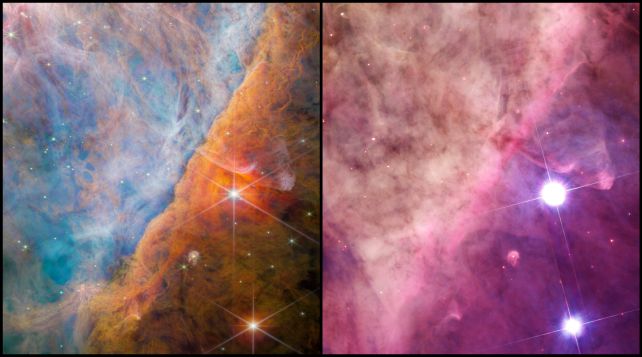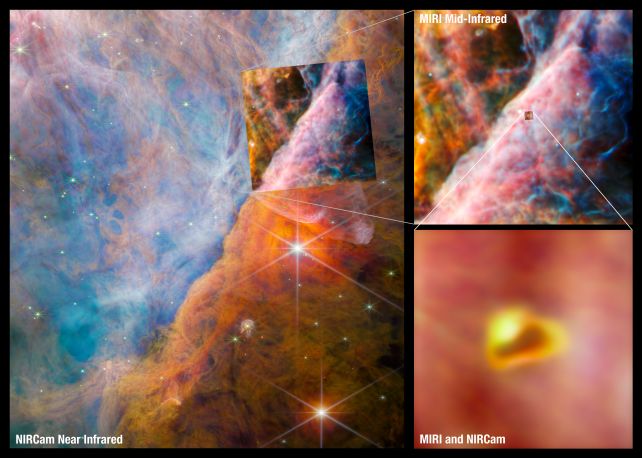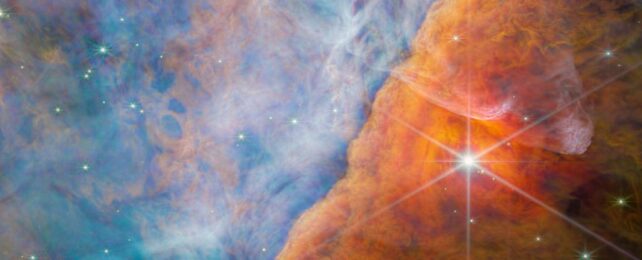Deep in the delicate traceries of the Orion Nebula, we've finally found an important carbon molecule never before seen in interstellar space.
Methenium, also known as the methyl cation (CH3+), is a carbon compound long predicted to play a pivotal role in organic chemistry in interstellar space. Now, using the James Webb Space Telescope, scientists have identified it in the disk of dust and gas surrounding a baby star, confirming the plausibility of this role.
Although CH3+ is not considered one of the essential ingredients for life, scientists believe that it helps build more complex carbon molecules. Since life as we know it is carbon-based, finding CH3+ in interstellar space has implications for our understanding of how life might emerge elsewhere in the galaxy.
"This detection not only validates the incredible sensitivity of Webb but also confirms the postulated central importance of CH3+ in interstellar chemistry," says astronomer Marie-Aline Martin-Drumel of the University of Paris-Saclay in France.
CH3+ is a very interesting molecule. It reacts with a wide range of other molecules, but not the most abundant element in our Universe, hydrogen. This means it has the potential to be a stepping stone along the way to the creation of more complex molecules within interstellar environments – a cornerstone, scientists have believed for decades, of interstellar carbon-based, or organic, chemistry.

But it was a no-show in observations outside the Solar System, meaning that we could not be certain of its presence or role. Many such observations are done in the radio spectrum; but CH3+ lacks the necessary features to be observable by radio telescopes.
That's where JWST comes in. Its exceptional infrared sensitivity makes it ideal for probing the sorts of dusty environments where CH3+ is expected to be found, since infrared light can travel through dust where other wavelengths scatter.
Led by astronomer Olivier Berné of the University of Toulouse in France, a team took a closer look at the Orion nebula, as captured by JWST's mid-infrared spectrometer. There, they found puzzling bright lines in the spectrum that, ultimately, could best be explained by the presence of CH3+.
The location of this detection was in a disk of dust and gas swirling around a red dwarf star named d203-506. This is a common feature of new stars; they are born from a dense knot of material in a molecular cloud in space that collapses under gravity. As this object spins it spools in material, arranging into a disk that swirls around the emerging star like water around a drain.
Once the star is formed, what remains of the disk starts to form other objects that make up a planetary system, such as, well, planets, and asteroids, and comets, and moons. Our Solar System was born from such a disk; studying disks around other stars can help us understand how the Solar System formed, and how life emerged here.
There is one pretty major sticking point. The protoplanetary disk of d203-506 is being heavily irradiated by harsh ultraviolet light from massive stars in the nearby vicinity, and this is thought to be a common stage in the life of protoplanetary disks, since most stars form in stellar nurseries, where these massive stars are common. Evidence from meteorites suggests that our Solar System went through a stage like this, too.

Such radiation is thought to have a pretty destructive effect on complex organic molecules. So figuring out how they survived well enough for life to emerge later has been a bit of a head-scratcher.
Fortunately the team found a solution to this pickle. According to their analysis, ultraviolet light promotes the formation CH3+. And the ultraviolet irradiation doesn't last a very long time, cosmically speaking: the massive stars spewing it out are short-lived, lasting just a few million years before dying.
So, once the molecule is present, and the massive stars gone, CH3+ can go on to help form more complex carbon molecules.
"This clearly shows that ultraviolet radiation can completely change the chemistry of a proto-planetary disc," Berné says.
"It might actually play a critical role in the early chemical stages of the origins of life by helping to produce CH3+ – something that has perhaps previously been underestimated."
Questions remain about the properties of this molecule, and the role it plays in interstellar chemistry. Future research, the team says, will tackle these.
The research has been published in Nature.
